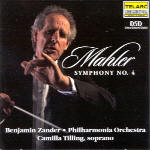Ben Zander really knows his Mahler, perhaps a bit too well in this case. His view of the Fourth Symphony reveals a determination to delve into the score’s minute details, often at the expense of the bigger picture. For example, he has the Philharmonia cellos keenly observant of dynamics and accent in the first movement’s second subject, but how anemic, how lacking in flow the music sounds as a result! Zander correctly understands the need for touches of rubato in places such as this, but seldom makes them sound naturally convincing: mannered, rather. The music limps where it should glide. Similarly, in the same movement’s development section when Mahler breaks up his long melodies into little bits tossed between sections of the orchestra, Zander’s exaggerated hairpin dynamics, punched out accents, and ever so slightly slow tempo chops up the phrases into a series of isolated incidents just when the conductor’s overriding concern should be finding the continuity in this colorful Mahlerian mosaic. The result comes across as mechanical, even pedantic.
Exaggeration beyond the call of duty also characterizes the scherzo, its solo violin crossing the line into self-parody. Another problem with Zander’s “micro-manage all of the details” approach is that if you’re going to do it that way, you have to take it to the limit, and there are too many points that he and his players miss. For example, the luscious “heavenly” interlude in this movement’s second trio (figure 11) sorely needs more harp; the return to Tempo I after Figure 12 is very clumsily managed, and the quiet percussion fails to color the texture as it should: suspended cymbals in the first movement and finale and the quiet tam-tam at the end of the scherzo are generally inaudible. In the great slow movement, despite an aptly flowing tempo and some lovely string phrasing, those big “collapse” episodes in the minor key variations progressively suffer from a lack of tension, due in part to less than sharp ensemble and weak basses, as well as a tendency to rush. The big climax, though, is terrific, while on the other hand Zander’s handling of those delightful, abruptly accelerating variations that immediately precede it culminates in a disappointingly hurried account of the poetic horn call to which they lead.
Soprano Camilla Tilling sings the finale with an appropriately innocent tone, but (despite Zander’s claims to the contrary in his accompanying talk) fails to characterize the text with any special charm or insight. She’s certainly not up to the level of Bernstein’s Reri Grist or Abravanel’s Netanya Davrath. The voice, for example, certainly does not laugh along with St. Ursula in the final stanza, sounding instead like so much of this performance, studied rather than spontaneous, particularly at Zander’s anaesthetized tempo. And despite much fine playing from the Philharmonia winds and brass, and generally good sonics, the orchestra still lacks a bottom. At quiet dynamic levels, cellos and basses all but disappear, and if the left/right division of violins accurately reflects Mahler’s intentions, their often-thin tone surely does not. Kubelik, for one, used the same seating plan with no ill effects whatsoever. This performance also stands in stark contrast to Yoel Levi’s recent recording of this same symphony for this same label, a rendition that features better playing still (especially from the strings), every bit as much interpretive nuance, and never gives undue prominence to tiny details at the expense of musical continuity.
The appended bonus disc, containing an 80-minute discussion of the symphony, lasts about 60 minutes longer than it needs to. I understand that many listeners might find these discussions interesting, and Zander’s strength lies in his perceptive analysis of the formal and structural details of the music itself. The asides, anecdotes, and digressions, however, are wearisome, as is the barely concealed smugness, the self-serving paean of praise directed at the orchestra, and the “infomercial”-style delivery. There is a two-fold danger here in the way Zander specifically characterizes such things as Tilling’s singing (“like sunlight sparkling on water” or some such), or Christopher Warren-Green’s violin playing (“evil”).
First, listeners may not hear what he is talking about at all and thus feel inadequate as a result, especially when the actual musical sounds are–as often in these cases–at variance with (or not clearly evocative of) Zander’s characterizations of them. Second, it’s difficult not to see Zander, as with Shostakovich’s descriptions to communist party officials of his symphonies as “optimistic and triumphant”, cynically attempting to manipulate the perceptions of those he regards as less musically aware than himself. Shostakovich, of course, had good reasons for adopting this tactic. Zander needs to give his potential audience more credit as serious listeners, and let them draw their own conclusions rather than imposing his own, or (in the worst case scenario) attempting to conceal the performance’s musical inadequacies behind a façade of fanciful rhetoric. Despite all of the foregoing, this isn’t by any means a bad recording. It’s respectful, often characterful, and well if not spectacularly played. Still, the fact remains: both verbally and interpretively Zander promises more than he delivers.
































